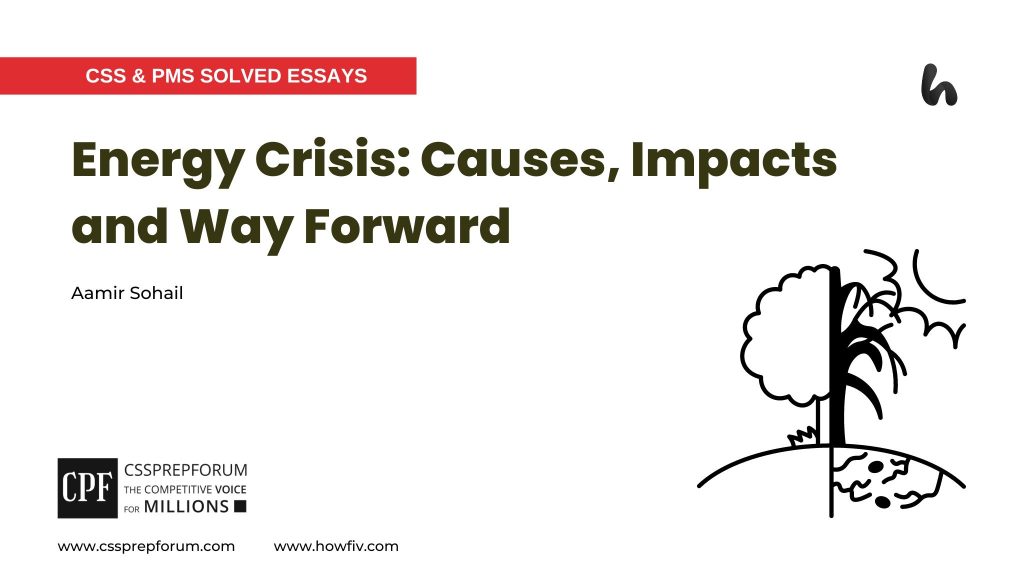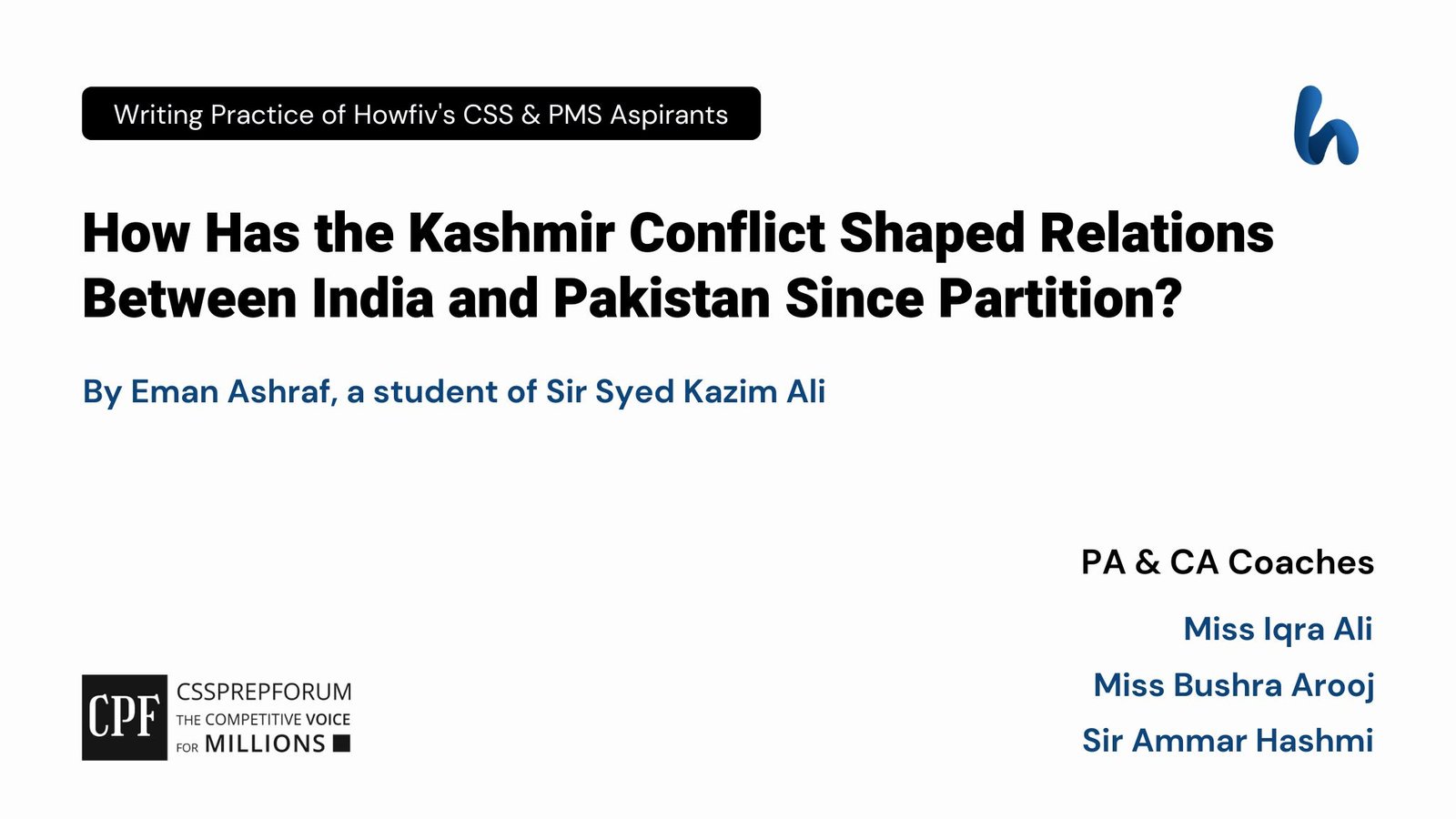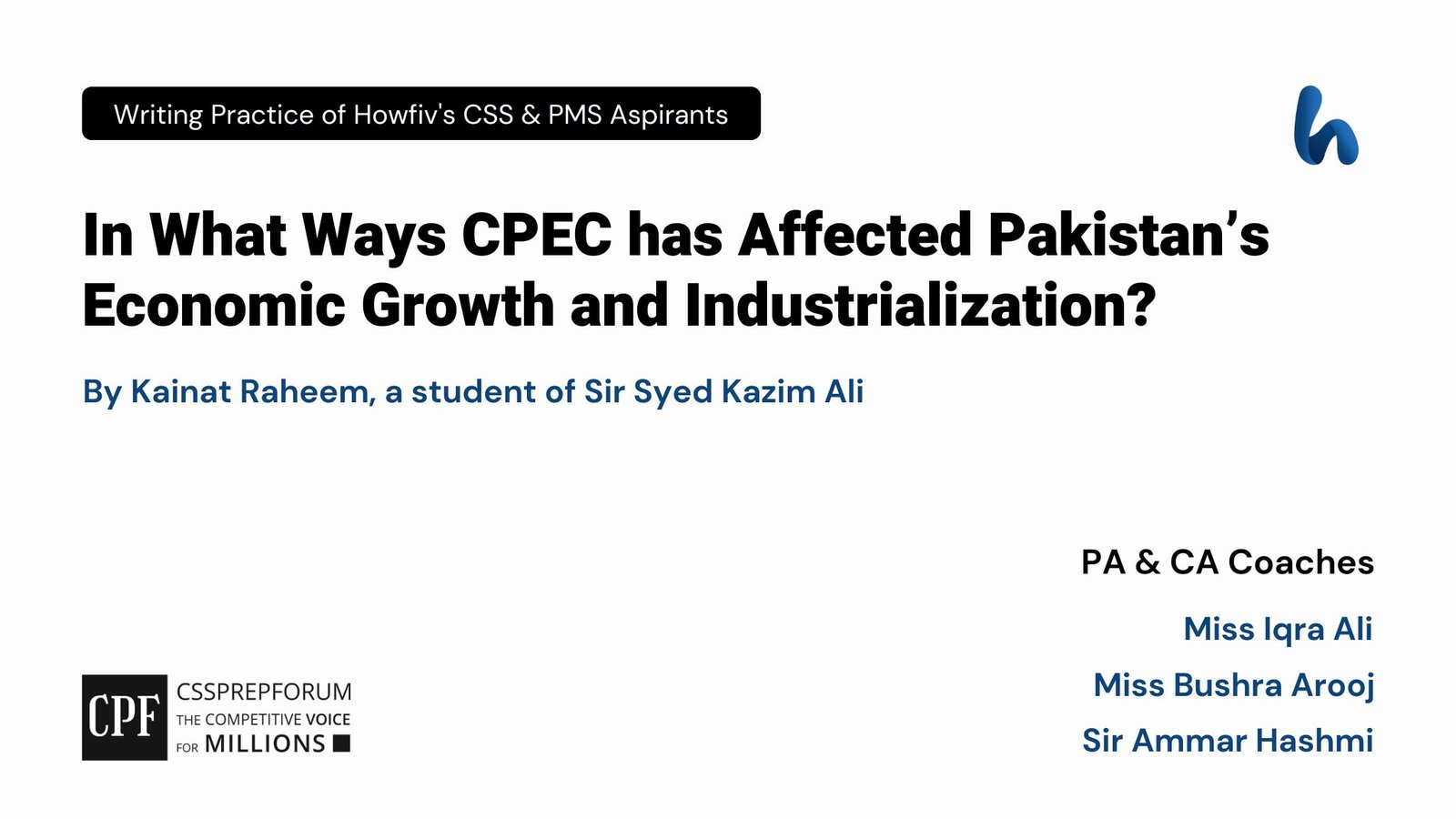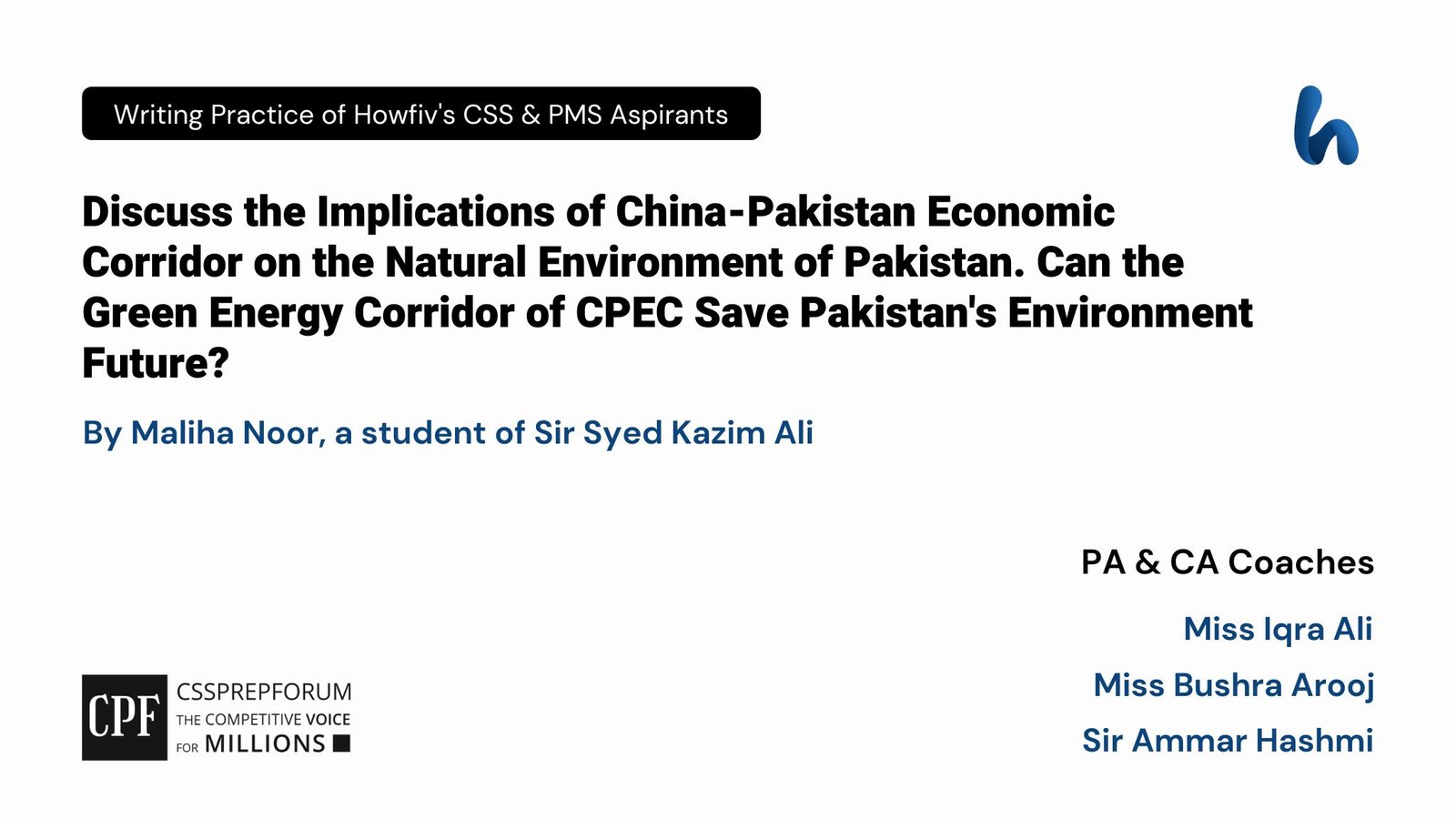CSS and PMS Solved Essays | Energy Crisis: Causes, Impacts and Way Forward
Aamir Sohail, a Sir Syed Kazim Ali student, has attempted the CSS essay “Energy Crisis: Causes, Impacts and Way Forward” on the given pattern, which Sir Syed Kazim Ali teaches his students. Sir Syed Kazim Ali has been Pakistan’s top English writing and CSS, PMS essay and precis coach with the highest success rate of his students. The essay is uploaded to help other competitive aspirants learn and practice essay writing techniques and patterns to qualify for the essay paper.

Outline
1- Introduction
2- Understanding the term: energy crisis
3- A brief overview of the energy crisis in Pakistan on all fronts
4- What are the causes behind the severe energy crisis in the country?
- ✓The high demand-supply gap
- Case in point: The Ministry of Power Division report, 2023, highlights demand of 30,154 MW against supply of 22,000 MW
- ✓Aged power generation plants and energy infrastructure
- Case in point: Guddu thermal power station established in 1968 and Muzaffargarh thermal power station in 1978, glaring examples in this case
- ✓Deadlock on major power projects
- Case in point: Indecision and propaganda on Kalabagh and Diamer-Bhasha dams
- ✓Inadequate management of power resources
- Case in point: Pakistan Today report estimating 30% of power losses in transmission
- ✓Lack of energy conservation and efficiency
- Case in point: Inefficient household appliances and industrial process
- ✓Over-dependence on imported fuel for energy generation
- Case in point: Research by the Asian Development Bank concluding that oil accounts for 31% of the total energy supplies in Pakistan
5- What are the consequences the country faces due to the rising energy crisis?
- ✓Surging of circular debt
- Case in point: The Ministry of Finance reporting Pakistan’s outstanding circular debt as 2.31 trillion in 2022
- ✓Rising power prices for consumers
- Case in point: Increasing of up to 27 per cent in NEPRA tariff with effect from FY 23-24
- ✓Shutting down of industries in the country
- Case in point: Closure of textile and steel mills in the country
- ✓Increasing current account deficit due to fuel import
- Case in point: Express Tribune report, 2023, indicating $2.03 billion in petroleum-related imports
- ✓Disruptions in electricity and gas supplies
- Case in point: The 2022 Floods in the country leading to power outages and blackouts
- ✓Creating social unrest in society
- Case in point: August 23 protests in the country against massive increase in bills
6- Suggestions to overcome the energy crisis faced by Pakistan
- ✓To promote the use of renewable energy
- ✓To mainstream energy policy in national agendas
- ✓To revisit independent power purchase agreements and tariff determination
- ✓To improve energy efficiency
- ✓To attract investment in the energy sector
- ✓To raise public awareness about energy conservation
7- Critical Analysis
8- Conclusion

The uninterrupted supply of energy is not only essential but also critical for the socioeconomic growth of a country. It not only enhances the quality of life for the citizens but also fuels the commercial activities of various industries, thereby driving sustainable economic growth. On the other hand, the energy supply disruption poses significant challenges for a country, undermines its socioeconomic fabric, and leads to a crisis dilemma. Unfortunately, Pakistan is struggling with an energy crisis that has severely impacted the country’s social and economic development. There are several reasons behind this catastrophic energy crisis, including the high supply-demand gap and aged power generation infrastructure. Furthermore, extravagant use of energy resources, inadequate management of power resources, and over-dependence on imported fuel have further exacerbated the situation. These issues have had grave consequences for the country, including a sharp increase in power prices and the surging of circular debt. Moreover, the crisis has led to the shutdown of several industries, affecting businesses’ productivity and ultimately leading to unemployment in the country. However, all hope is not lost. The rampant energy crisis can be overcome if the government introduces measures to promote renewable energy sources, encourage efficient energy use, and mainstream energy policy in critical national decisions. The government must prioritize this issue and take immediate steps to implement strategic plans to address this crisis. By doing so, not only will the energy crisis be overcome, but it will also pave the way for sustainable economic growth, employment opportunities, and a better quality of life for the citizens of Pakistan.
Energy crisis is the severe shortage of energy resources in a particular country or the world. It results from an imbalance between energy supply and demand, which results in a shortfall of energy to required consumers. Energy crises can lead to several adverse consequences for a country, including, but not limited to, economic, social, and political impacts. The recent global energy crisis is evident after COVID-19, which resulted from the war in Ukraine and the global shift towards clean energy.
Pakistan has been grappling with a daunting energy crisis that has brought multifaceted challenges for the country. It has debilitated the country’s progress on the socioeconomic and environmental fronts. According to the Ministry of Power Division report 2023, the country’s electricity demand is 30,154 MWs against a supply of 22,000 MWs, resulting in a shortfall of over 8,000 MWs. The severe crisis has resulted in repeated load shedding, frequent power outages, and chronic electricity and gas supply disruptions to households and industries. The energy crisis has engulfed Pakistan on all fronts, and it is having negative impacts on the country’s economy, environment, and well-being.
Myriad causes have led to the energy crisis in Pakistan. The high demand-supply gap is the major reason behind the country’s energy crisis. The energy demand constantly increases while the supply remains stagnant due to production constraints. According to the Ministry of Power Division report 2023, the country’s electricity demand is 30,154 MWs against a supply of 22,000 MWs, resulting in a shortfall of over 8,000 MWs. This has led to the widening gap between supply and demand, which has put pressure on the country’s energy infrastructure and made it difficult to meet household and commercial demands. Hence, the increasing gap between demand and supply has led to the energy crisis in Pakistan.
Second, the aged power generation plants and energy infrastructure have led to the energy crisis in the country. It has led to increased production costs, frequent operations closures, and repeated shortfalls in power generation targets. For instance, the Guddu thermal power station and Muzaffargarh thermal power station established in 1968 and 1978, respectively, have surpassed their useful life and are no longer operating at their optimum capacity. The energy infrastructure has not been improved considering the contemporary demands and trends, and as a result, it has led to lower power generation. Thus, the aged power generation plants and sub-standard energy infrastructure have contributed to the energy crisis.
Besides aged power generation plants, another reason behind the severe energy crisis in Pakistan is the deadlock on major power projects. Several projects were initiated with great zeal and commitment, but their completion failed to materialize due to multiple issues. This is best illustrated with the examples of Kalabagh Dam and Diamer-Bhasha Dam, where indecision and propaganda have halted the development and execution of the projects. The latter has been stalled due to financial constraints and security concerns, while the former has remained in limbo due to regional disputes and political propaganda. Therefore, the deadlocks and delays on significant power projects have led to the energy crisis in Pakistan.
Moreover, the inadequate management of the country’s power resources has led towards the energy crisis. The transmission and distribution network is outdated and inefficient, which results in significant energy losses. According to a report by Pakistan Today, the country has 30% of power losses during transmission. The power loss during the transmission and distribution process further constrains the limited energy supply, ultimately leading to power outages and energy shortfall in the country. Hence, the inadequate management of the country’s power resources, particularly during the transmission and distribution process, has led to the energy crisis.
Furthermore, the lack of energy conservation and efficiency measures has further exacerbated the energy crisis in Pakistan. The extravagant use of energy sources and inefficient usage of power resources in residential and commercial sectors have made it difficult for the country to meet the growing energy demands. For instance, inefficient household appliances and unproductive industrial processes have worsened the situation. Many Pakistani households use old equipment that consumes more energy than updated appliances. The industrial sector consumes more energy due to adherence to traditional ways of production without being aware of the optimum energy mix. Hence, the lack of energy conservation and efficiency measures has contributed to the energy crisis in Pakistan.
In addition, over-dependence on imported fuel for power generation is also the major factor behind the energy crisis in Pakistan. Pakistan’s energy infrastructure is primarily based on non-renewable energy resources, and the country imports fossil fuels to meet its energy demands. According to research by the Asian Development Bank, oil accounts for 31% of the total energy supplies in Pakistan. The over-dependence on imported fuel makes the country vulnerable to global oil price changes and supply disruptions, thus affecting the country’s power generation capacity. Therefore, the excessive reliance on imported fuel has contributed to the energy crisis in the country.
These factors indeed have grave consequences for Pakistan. First, the surging of circular debt is a major consequence of the energy crisis. In circular debt, different entities in the energy supply chain own each other some dues. In Pakistan, it has mounted due to a series of non-payments to power plants. According to the Ministry of Finance, Pakistan has an outstanding circular debt of Rs. 2.31 trillion in 2022. Circular debt has surged due to the increasing cost of electricity and non-payments from consumers, ultimately resulting in power plants’ long-outstanding receivables from the government. Hence, the massive rise in circular debt is a major impact of the energy crisis.
Second, the rise of power prices for consumers is one of the primary consequences of the energy crisis. Power prices in Pakistan reached an unprecedented level in 2023 and bewildered citizens due to the excessive increase in electricity tariffs. For instance, the National Electric and Power Regulatory Authority (NEPRA) has announced up to a 27% increase in electricity tariffs from the Financial Year 2024. Despite the government’s efforts to control price hikes, electricity prices are inflated due to a severe energy crisis. Therefore, the increase in electricity tariff is a major consequence of the energy crisis.
Besides rising prices, the energy crisis has contributed to the shutdown of industries in the country. Due to frequent load shedding and power outages, it has disrupted business activities and forced businesses to shut down. This is best illustrated by the case of textile and steel mills in the country, which depend heavily on the smooth energy supply to operate and sustain in the competitive world. However, the unreliable power supply has made it difficult for the mills to plan their productions and operations, ultimately leading to decreased production and potential closures. Therefore, the energy crisis is the major reason behind the closure of industries in the country.
Furthermore, the energy crisis has contributed to the surge in the current account deficit. The imported fuel holds a major percentage in the country’s energy mix. According to the Express Tribune report, in 2023, Pakistan imports $2.03 billion in petroleum-related products annually. The energy crisis has led to increased demand for imported fuel, which has put pressure on scarce foreign exchange reserves and led to a current account deficit in the country. The country’s reliance on imported fuel and the payment in foreign currency has contributed to the massive rise in the current account deficit.
In addition, disruptions in electricity and gas supplies are also a consequence of the energy crisis. Frequent power shortages and outages have disrupted both residential and commercial activities. For example, the 2022 floods in the country led to power outages and blackouts in major portions of the country. These disruptions in power supplies are not only because of an increase in power shortfalls but also due to inadequate transmission and distribution crises that further exacerbated the situation. Thus, the energy crisis has resulted in frequent disruptions in power supplies to the country’s citizens.
Last but not least, the energy crisis has led to social unrest. Regular load shedding in the country, high electricity rates, and severe economic implications of the energy crisis have pulled people to the streets to protest against the crisis. The case is best illustrated by the August 23 protests in Pakistan, where a large number of citizens held protests against the massive increase in electricity bills. The unprecedented hike in power prices, especially from July 2023, has undeniable adverse impacts on the country’s citizens, who are increasingly turning to demonstrations to record their grievances against the government. Hence, the social unrest due to protests and demonstrations against the increase in bills has, in fact, been caused by the energy crisis.
To overcome the energy crisis, the country should promote using renewable energy. Renewable energy sources such as solar, hydel, and geothermal power offer a sustainable and environmentally friendly alternative to fossil fuels. Indeed, the country can reduce its reliance on imported fuel by shifting towards renewable energy sources to meet its domestic demands. Furthermore, energy policy must be mainstreamed in all national agendas to counter the menace. It means incorporating energy policy in critical national decisions and policy-making at the strategic level to ensure that the country’s energy demands are met adequately.
Second, the country should revisit independent power purchase agreements (IPPAs) and tariff determination methods to counter the energy crisis. Independent power purchase agreements between power producers and distribution companies were signed at high rates during the energy crisis, and the cost-sharing mechanism was inadequately adhered to. The country can overcome the energy crisis by re-negotiating IPPAs, ensuring transparency in tariff determination, and identifying loopholes in tariff petitions. In addition, attracting investment in the energy sector is crucial for addressing the energy crisis in Pakistan. By providing a favourable investment climate, the country can attract investors in the power sector, ensuring increased production, improvements in energy infrastructure, and a sustainable energy mix.
Furthermore, the country can overcome the energy crisis by improving energy efficiency. It should focus on promoting efficient energy appliances and technologies, improving buildings’ energy standards, and conducting energy audits to curb wastage and inefficient consumption of scarce power resources. Lastly, raising public awareness about energy conservation is imperative to address the crisis. Several measures, such as public awareness campaigns, community leaders’ engagement, and media collaboration, can aid in overpowering the crisis in the country. It will empower and educate the citizens and help eradicate reliance on imported fuel. Thus, Pakistan can overcome the energy crisis by mobilizing the public and ensuring energy-efficient practices.
To conclude, Pakistan faces an acute energy crisis that has debilitated social and economic developments in the country. The widening gap between the energy supply and demand has resulted in frequent load shedding and power outages in the country. While an efficient energy supply is essential for socioeconomic and environmental development in a country, its disruption poses severe challenges. It leads to a quagmire of issues for an energy-starved country. There are several reasons behind the severe energy crisis in the country, and they have grave consequences for Pakistan indeed, as evidenced by the unprecedented increase in power prices and the surging of circular debt in the country. Nevertheless, the rampant energy crisis could be overcome if the government introduces measures to promote renewable energy sources, encourages efficient energy use, and makes a mainstream energy policy.

CSS Solved Past Papers’ Essays
Looking for the last ten years of CSS and PMS Solved Essays and want to know how Sir Kazim’s students write and score the highest marks in the essays’ papers? Then, click on the CSS Solved Essays to start reading them.
CSS Solved Essays
CSS 2022 Solved Essays
Are you searching for CSS 2022 solved essays by Sir Syed Kazim Ali’s students? Click on any of the topics to start reading the solved essays.
| 1- | An analysis of the concept of globalization of markets. |
| 2- | Digital democracy: social media and political participation. |
| 3- | Global trade and trade policies of China. |
| 4- | “Imagination is more important than knowledge”. |
| 5- | Global politics and international relations. |
| 6- | The controversial issues of feminism in contemporary women’s rights movements. |
| 7- | World food systems: the economics of agriculture. |
| 8- | Is there such a thing as ethical consumerism? |
| 9- | Human development and economic sustainability. |
| 10- | How are terrorism and its perception shaped by the Mass Media? |
CSS Solved General Science & Ability Past Papers
Want to read the last ten years’ General Science & Ability Solved Past Papers to learn how to attempt them and to score high? Let’s click on the link below to read them all freely. All past papers have been solved by Miss Iqra Ali & Dr Nishat Baloch, Pakistan’s top CSS GSA coach having the highest score of their students. General Science & Ability Solved Past Papers
Articles Might Interest You!
The following are some of the most important articles for CSS and PMS aspirants. Click on any to start reading.












